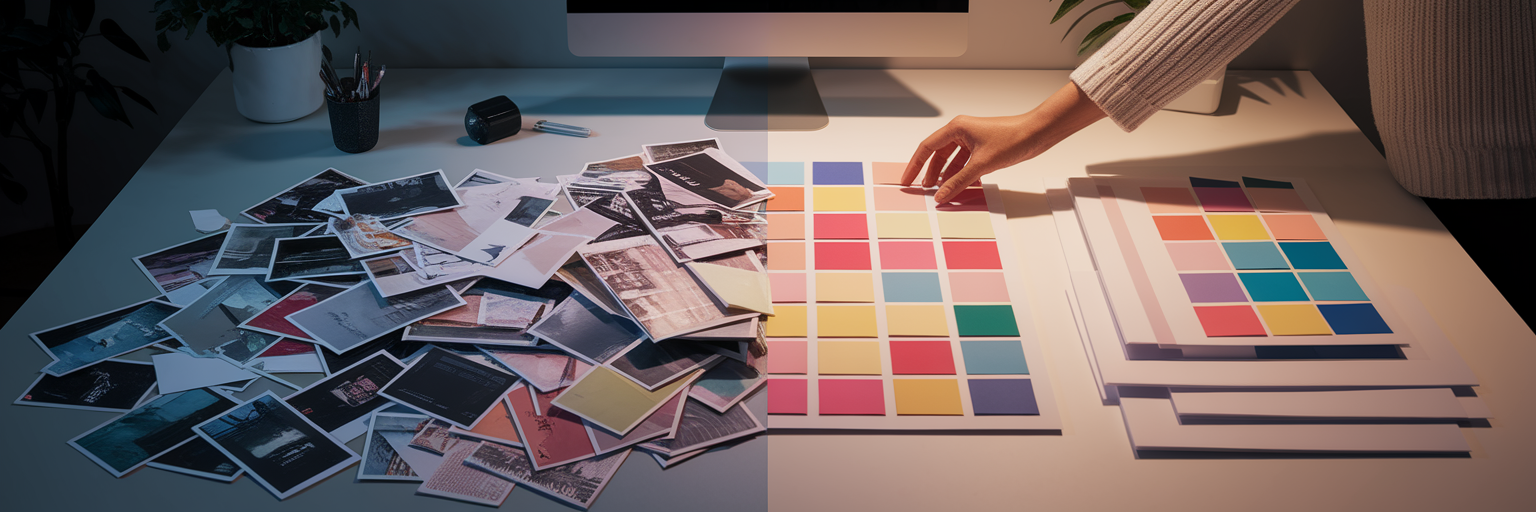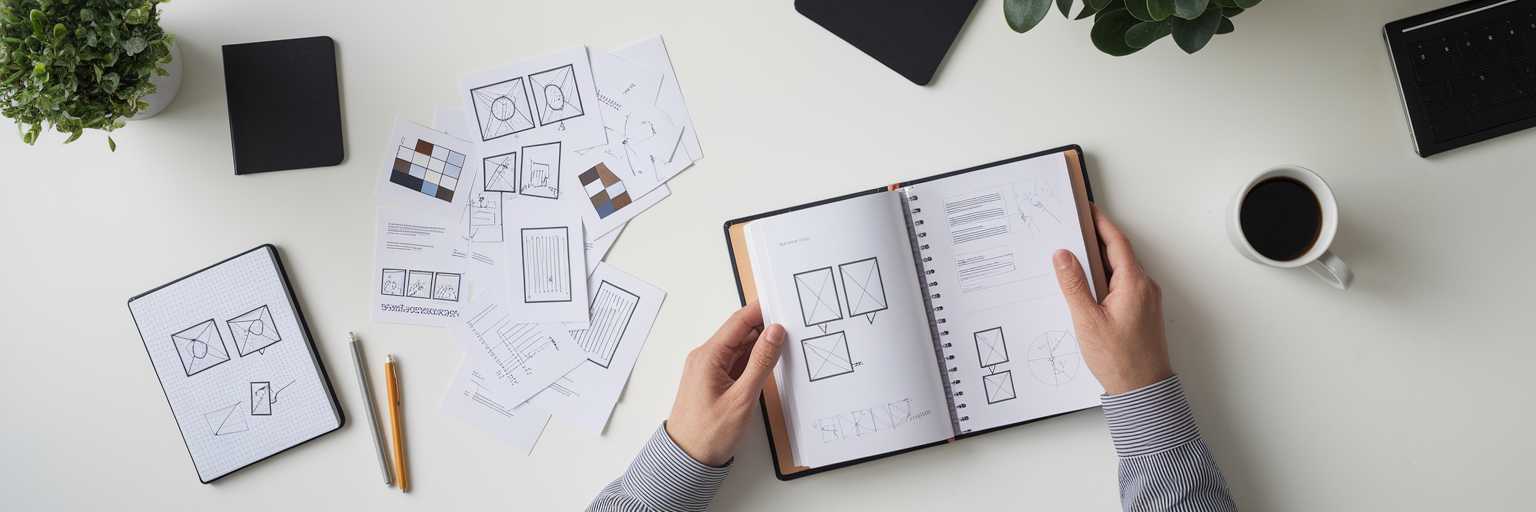Picture this: a client needs a landing page prototype in 48 hours. You have a great sense of what looks good, but your inspiration is a digital mess. It's scattered across 50 browser tabs, a desktop folder vaguely named 'stuff', and random screenshots on your phone. This creative chaos is the enemy of efficiency.
For a freelance developer, time is money, and that chaos costs you both. The solution isn’t to stop collecting ideas, but to build a system that works for you, not against you. An organized library of design inspiration is a tangible asset that saves precious hours, reduces project stress, and leads to higher-quality work. This is especially true when the clock is ticking.
Learning how to organize design inspiration is the key to meeting tight deadlines without sacrificing creativity. This guide will show you how to transform that messy workflow into a streamlined process. Ready to get started? You can begin building a better system today by trying Bookmarkify for free.
The Freelancer's Dilemma: Creative Chaos vs. the Clock
We’ve all felt that pressure. The client is excited, the deadline is firm, and your brain is buzzing with ideas. But when you sit down to start, you spend the first hour just trying to find that one perfect reference you saved last month. Was it a bookmark? A screenshot? A link you sent to yourself on Slack? That lost time is where projects go off the rails.
This isn't just a minor inconvenience. It’s a fundamental flaw in the typical freelance developer workflow. When your inspiration is disorganized, you lose momentum. You break your creative flow by hunting for files, and you risk delivering work that feels rushed or disconnected simply because you couldn't access your best ideas when you needed them most.
The goal is to turn your collection of ideas from a liability into a professional toolkit. An organized system means you can pull up vetted examples of great UI, animations, or layouts in seconds. It allows you to respond to client feedback with confidence and build better products, faster. It’s time to stop letting chaos dictate your process.
Laying the Groundwork with Smart Project Organization
Before you can effectively organize your inspiration, you need a clean workspace. Think of it like a chef’s kitchen: everything has its place so you can move quickly and efficiently. A solid project structure is the foundation for a stress-free creative project management process.
Here are a few steps to build that foundation:
- Standardize Your Folder Structure: Create a consistent template for every new project. A simple structure like
/Client_Name/Project_Name/ with subfolders for /Assets, /Code, /Feedback, and /Inspiration creates predictability. You’ll never waste time wondering where to save a file again.
- Map Your Workflow Visually: Use a tool like Trello or Notion to create boards with columns for each stage of your project, such as 'Backlog', 'Inspiration', 'Wireframing', and 'In Development'. This gives you a bird's-eye view of your progress and keeps everything in one place.
- Build a Reusable Asset Library: Every developer has a personal toolkit of go-to fonts, icons, and code snippets. Keep these in a central, easy-to-access location separate from project-specific files. This is your personal library, ready to be deployed at a moment's notice.
As creative professionals on platforms like LinkedIn often advise, a streamlined file system is the first defense against project chaos. Getting this structure right from the start prevents your entire workflow from collapsing under the pressure of a tight deadline.
From Passive Collection to an Active Inspiration Library

Most of us are passive collectors. We see something cool, right-click 'Save Image As...', and drop it into a generic folder. Or we hit the bookmark star and let it disappear into a list of hundreds of other links. This is hoarding, not organizing. The shift you need to make is toward active curation: purposefully building a searchable, context-rich library.
This is where visual bookmarking for developers becomes a powerful ally. Instead of a simple text link, tools like Bookmarkify are built for creatives, capturing the visual essence of a webpage. You see a preview of the site, making it instantly recognizable.
Picture this: you need to find that perfect button animation you saw weeks ago. Instead of trying to recall which of 100 saved links it was, you simply filter your visual library by tags like 'buttons' and 'micro-interactions'. In seconds, you see visual previews of every relevant example you’ve saved. That’s the power of an active library.
Here’s an actionable first step: find five examples of great UI from your existing messy bookmarks. Add them to a dedicated visual tool and give them a few simple tags. You’ll immediately feel the difference. To get a head start, you can even browse curated collections of daily inspiration and start building your library with high-quality examples.
The Developer's Guide to Tagging and Categorization
A library is only as good as its searchability. For a freelance developer on a deadline, speed is everything. A smart tagging system is what transforms your collection from a digital shoebox into a high-speed database of ideas.
Start with broad categories that are relevant to your work: 'UI Components', 'Layouts', 'Color Palettes', 'Typography', and 'Animations'. From there, get specific with a simple but powerful tagging formula: [Element] + [Style] + [Technology]. Instead of a vague tag like 'form', you might use `login-form`, `minimalist-design`, and `react-component`.
Here are some practical tags to get you started:
- `data-visualization`
- `tailwind-css-gallery`
- `mobile-navigation`
- `onboarding-flow`
- `pricing-table`
- `dark-mode-ui`
This system makes finding hyper-specific examples incredibly fast. When a client asks for 'a modern dashboard,' you can filter by `saas-dashboard` and `data-visualization` to instantly pull up relevant examples you’ve already vetted and approved.
| Inspiration Type |
Vague Tag (Slows You Down) |
Specific Tag (Speeds You Up) |
| Login Form |
form, ui, cool |
`login-form`, `minimalist-design`, `social-login` |
| Pricing Page |
pricing, saas |
`pricing-table`, `saas-tier-layout`, `feature-comparison` |
| Navigation Bar |
nav, header |
`mobile-navigation`, `mega-menu`, `sticky-header` |
| Data Chart |
dashboard, chart |
`data-visualization`, `d3-js-example`, `real-time-graph` |
Build Moodboards That Get Client Buy-In Faster

A moodboard for developers isn't just an artistic exercise. It's a crucial communication tool that saves time and prevents costly revisions. Getting a client to agree on a visual direction *before* you write a single line of code is one of the most effective ways to protect your time and profit margins.
An organized library makes this process effortless. Instead of hunting for new examples for every project, you can pull pre-tagged inspiration directly from your curated collections. For example, if a client wants a 'clean and friendly' app, you can quickly create a collection with items you've tagged `minimalist-ui`, `friendly-illustrations`, and `sans-serif-fonts`.
Tools like Bookmarkify offer a moodboard view designed for this exact purpose, letting you arrange visual bookmarks into a compelling narrative. You can then share the entire collection with a simple link for feedback. This alignment ensures everyone is on the same page, reducing the chances of that dreaded "this isn't what I pictured" conversation down the line. For more tips on visual communication and other creative workflows, our blog covers a range of strategies.
Integrating Inspiration Directly into Your Workflow
The final piece of the puzzle is to bridge the gap between inspiration and execution. The goal is to minimize context-switching and embed your inspiration library directly into your development process. Start by linking specific inspiration collections to tasks in your project management tool. For example, a 'Build Header' card in Trello can link directly to a Bookmarkify collection of header designs.
Modern design inspiration tools also offer features that accelerate coding. Instead of opening a live site to check its responsiveness, you can use device previews within your bookmarking tool. With a feature like our Design Analyse tool, you can instantly inspect the fonts, colors, and assets from a saved reference, saving you from tedious manual inspection in your browser's developer tools.
This creates the ideal freelance developer workflow. When you get stuck on a component, you can dip into your own vetted library for a solution instead of getting lost in a new, distracting Google search. You move from a task in Trello, to a specific collection of ideas, and back to your code editor with a clear direction in minutes, not hours.
Maintain Your Library to Keep It a High-Value Asset

Your inspiration library is like a garden. It needs regular tending to remain a useful resource. An overgrown library filled with outdated trends or irrelevant examples becomes noise, defeating the entire purpose of the system.
The good news is that maintenance doesn't have to be a chore. Set aside just 30 minutes once a month to prune your library. Archive inspiration from completed projects and delete references that no longer feel fresh or relevant. This isn't just housekeeping; it's a strategic investment in a professional tool that will continue to deliver value on every project.
Building this system is a pivotal step for any freelance developer looking to work smarter, not harder. You can start building this system right now with Bookmarkify for free and save your first few curated inspirations today. Take control of your creative process and never let a deadline defeat you again.












